![]()
When Asus launched the updated ProArt Station PD5 earlier this fall, it looked poised to deliver a powerful, accessible machine to creative professionals. Unfortunately, despite lofty and worthwhile goals, the ProArt Station PD5 is not quite the impressive machine I had hoped for.
Regarding the PC market, there is no shortage of powerful machines of all shapes, sizes, and price points. However, with great choice comes great responsibility and, for many, skull-pounding headaches and the fear of making the wrong choice or not feeling confident building a computer themselves.
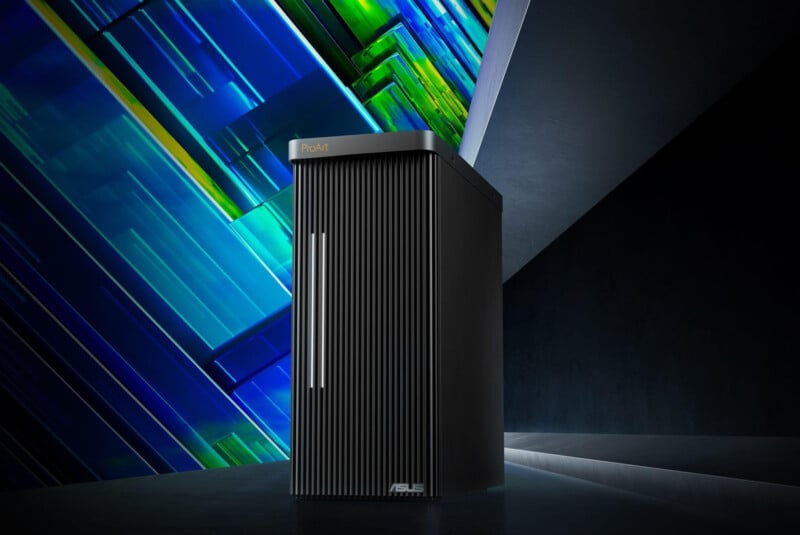
You can put me in that latter camp. As a lifelong Mac user, the idea of selecting from more than a handful of processor and memory options makes my head spin. As for the prospect of building a computer from scratch? No chance.
This is where the Asus ProArt PD5 excels; it is straightforward and approachable. When you head to Asus’s store, you have two options: the Asus ProArt Station PD5 PD500TC for $1,700 and the ProArt Station PD5 PD500TE for $2,700.
The unit I tested is the latter one, complete with an Intel Core i9-13900 2.0GHz processor (13th generation), 32GB of DDR4 U-DIMM memory (expandable up to 128GB of RAM), and the standard NVIDIA RTXA4000 graphics card with 16GB of VRAM.
Asus has said that users can purchase the ProArt with the GeForce RTX 4070 GPU instead, although that option has yet to be available. For the more courageous, popping the side cover off the machine and swapping components is always an option, unlike with Apple Silicon-powered Macs.
![]()
Design and Build Quality
Alongside the extreme diversity in the components people can put in their PCs, there is also a wide range of shapes and appearances, especially towers, that they can take. To Asus’ credit, it has done an excellent job making a PC tower that deserves to be prominently displayed. The ProArt Station PD5 looks very nice, with a ridged front fascia, a basic rectangular shape, gold text, and a pair of light bars, which can be customized to the color of your choosing and even be animated. These light bars can also serve a function, showing CPU, GPU, or RAM utilization in percentage.
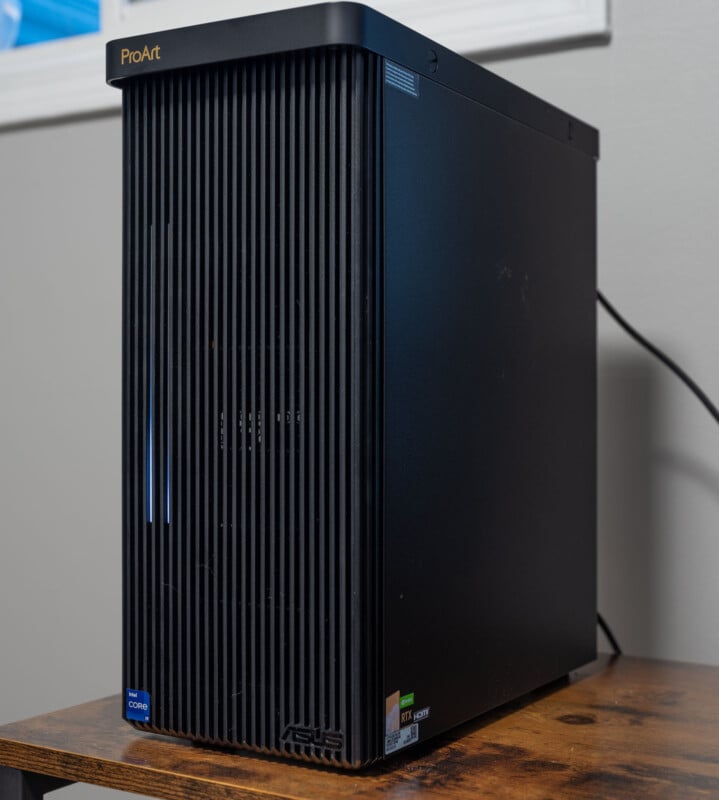
The ProArt falls short when it comes to its ports. It’s a machine built in 2023 with the modern creator in mind, so why is there only a single USB-C port? Frankly, it is confounding.
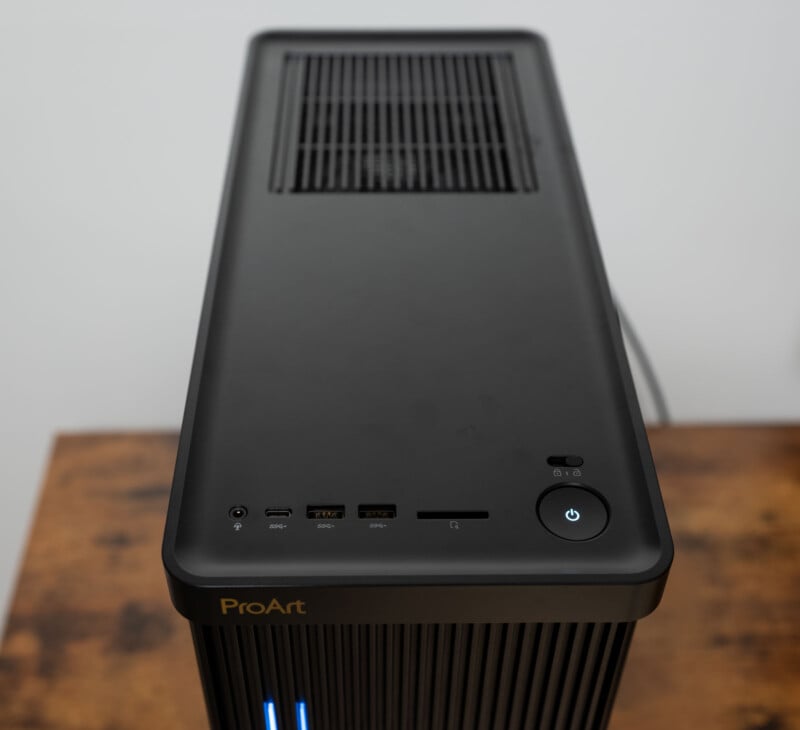
Further, the lone USB-C port, along with two USB-A ports and an SD card slot, are arrayed in a line on the top of the machine next to the power button. The front of the machine would make more sense for ports, even if it threw off the design language. The top of the machine also has a vent with the same grille design as the front of the ProArt and a headphone port.
Moving to the back of the PC, a fair bit is happening. As my machine was configured, there is an RJ45 Gigabit Ethernet port, a pair of HDMI ports, a Display port 1.4, one PS2 port, and six USB-A ports. Of the USB ports, which are also USB-A, only two offer USB 3.2 Gen 2 speeds, while the other four are USB 2.0. A blue plastic interior denotes the two faster ports. There are also three audio jacks that support 7.1 audio and a quartet of mini-DP ports.
Beyond the reliance on USB-A ports, which, at least to me, seems wildly outdated, the machine’s HDMI ports are underwhelming. They are merely HDMI 1.4. It’s baffling in 2023 when nearly every HDMI-equipped device ships with at least HDMI 2.0 ports, if not HDMI 2.1.
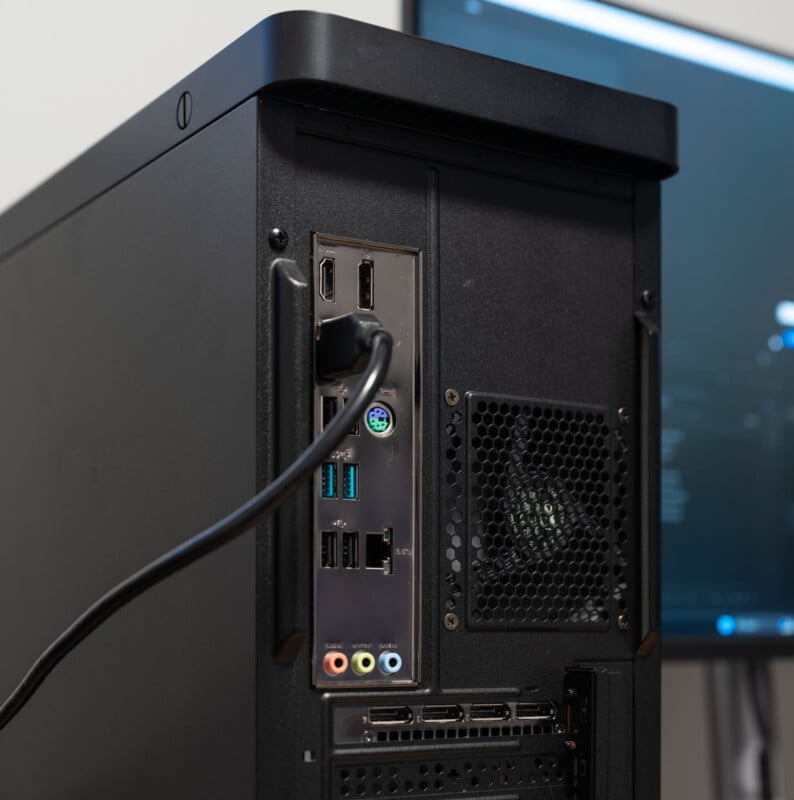
When using HDMI 1.4 at 4K resolution, it is technically possible to get a 60Hz refresh rate, which pushes beyond the limits of the standard, but at the cost of screen tearing and the inability to use HDR, which is one of the critical features of Asus’ ProArt monitor. The review of the monitor will be coming later.
To dive into this a bit further, while much of the talk online about HDMI 1.4 is that it is simply impossible to push a 4K signal to a monitor at 60Hz, that is not true, thanks to the wonders of chroma subsampling. However, this workaround comes at the cost of color performance. Instead, use the machine’s DisplayPort 1.4 technology if you intend to work at 4K resolutions.
Fortunately, it is not all bad news. The move from PCI Express Gen 3 to Gen 4, fixing one of the 2022 PD5’s most egregious missteps, is at least good.
While keyboard and mouse impressions are not often part of a desktop PC review, the Asus ProArt PD5 does, in fact, ship with a wired keyboard and mouse. There is not much to say here except that they are functional but should be replaced with superior peripherals as soon as possible. On the plus side, the wires are pretty long, which is not always a given with in-the-box accessories. Of course, when it comes to desk clutter, the long wires could instead be a negative.
![]()
As for the size and weight of the ProArt PD5, it is not monstrously large or impressively small. The tower is 16.42 x 16.05 x 7.09 inches (417 x 408 x 180 millimeters) and weighs just over 22 pounds (10 kilograms). It only requires a small amount of space and should work with most desks, but it is a far cry from something like a Mac Studio that you can put just about anywhere.
Something I take for granted with my Mac computers is their remarkable quietness, even when pushed to their limits. I can count the times I’ve heard the fan on an Apple Silicon device spin up on one hand. There are downsides to Macs, including relatively high price tags, a lack of upgradeability, and the fact that they lock their user into macOS (which is only a downside for some people but worth mentioning).
The Asus ProArt PD5 is reasonably quiet during typical use. However, during benchmarking tests, it sounded like it might be preparing for takeoff. It is all relative, of course, and the PD5 may very well be quieter than many comparable PCs, but to my sensitive Mac fanboy ears, the PD5 was a bit loud.
![]()
Performance
There are few surprises here, given that the ProArt PD5 does not feature the most impressive components. Following our benchmarking procedures with other machines, our test consists of importing 110 61-megapixel Sony a7R IV and 150 100-megapixel PhaseOne XF RAW files, generating 1:1 (Lightroom Classic), applying a custom-made preset with heavy global edits, and then exporting those same files as 100% JPEGs and 16-bit TIFF files. The tests are run three times, with the results below being an average of the trio of tests.
Lightroom Classic
The Asus ProArt PD5 did the worst of any computer in Adobe Lightroom Classic. Now, there’s a caveat here, as the PD5 is not miles worse than the competition. Someone has to be the slowest; in importing and generating previews, it’s the PD5.
![]()
However, when exporting JPEGs, the computer narrows the gap and even bests some of the competition. Compared to the MSI Creator Z17HX Studio, the PD5 is superior, meaning that the PD5 is not the worst Windows machine on our relatively small list of benchmarked computers. The ProArt tower also outpaces the M1 Ultra Mac Studio and M2 Pro Mac mini and does better with the PhaseOne files than the M2 Max MacBook Pro.
![]()
For 16-bit TIFF files, the story is much the same. The ProArt is better than the MSI Creator but worse than the other PCs. The ProArt is swifter than Apple’s M1 Ultra and M2 Pro-equipped machines and faster than the M2 Max MacBook Pro with the 100-megapixel images.
![]()
Photoshop
Next up is Puget Systems’ industry-standard PugetBench benchmark test for Photoshop. The test assigns an overall score, seen below, and breaks down individual performance segments into General, GPU, Filter, and PhotoMerge scores.
Looking first at the discrete breakdown, where, unlike Lightroom testing, higher is better, the ProArt PD5 is the least powerful PC we’ve tested with this standard test bench. It is close to the MSI Creator across some metrics but is generally not a super impressive performer.
Compared to our Mac tests, the ProArt PD5 is similar to M1 and early M2-era machines and is far behind the M2 Ultra and M3 Max, which arrived in the past six months.
![]()
The same trend matches the overall scores, although the gaps between the PD5 and the fastest PCs don’t look so ridiculous. The ProArt machine is the slowest on our list, but it is just a little behind the M2 Pro Mac mini and not far behind the MSI Creator.
![]()
Performance Takeaways
The PC and Mac machines that the ProArt got closest to, and in some cases bested, are either a notebook in the case of the MSI Creator or an older, cheaper Mac. The ProArt machine I tested is nearing $3,000, and the performance is not there.
If the more affordable PD500TC tower, which costs $1,700, can deliver anywhere near this level of performance, then that is the better choice, considering that, like the PD500TE, the entry-level version is hamstrung by the same poor ports.
The i9-13900 in the PD500TE is not terrible, but it could be better, too. The same goes for the RTXA4000 graphics card.
A Disappointing, Albeit Stylish and Straightforward Package
If I am operating system agnostic, meaning I do not strongly prefer macOS or Windows, then I would head the PC route because I want to get something really powerful and expandable that will not shatter my bank account in the way that Apple’s only genuinely flexible computer, the Mac Pro, does.
Unfortunately, that is not what the Asus ProArt PD5 offers. Instead of being blazing-fast at a reasonable price, it is merely an expandable PC tower that offers acceptable performance for the price, and I think “fine” might be a little bit generous. It is by no means bad or incapable of doing anything a photographer throws at it, but where it might come up short is when doing high-end video editing or 3D modeling, which are users that very much fall under the “creative professional” umbrella that Asus is targeting here.
![]()
It is not all bad news, though, as the PD5 does do some stuff very well. It looks good, which matters quite a bit to some customers. And while it is not as quiet as a Mac, it is also not ear-piercing when running at full steam. The front lights are lovely, although ideally, they would be a cherry on top of a delicious sundae rather than a noteworthy aspect of an otherwise not-amazing product.
In terms of offering PC users an accessible, straightforward tower that delivers acceptable performance, the Asus ProArt PD5 is an accomplishment. The issue is that instead of excelling or doing something exciting, the ProArt PD5 skates by and does the minimum I expect from it, and sometimes not even that.
Are There Alternatives?
Many of them, including the Intel NUC Extreme we reviewed at the top of this year. While that computer requires the user to put a bit of thought into the components they want, it is very feasible to compile a much more powerful machine at a similar price as the ProArt PD500.
What sinks the ProArt PD5 is not that its performance is mid, as the kids say, but that its ports are so thoroughly archaic, and customers are asked to pay a premium price for a less-than-premium product.
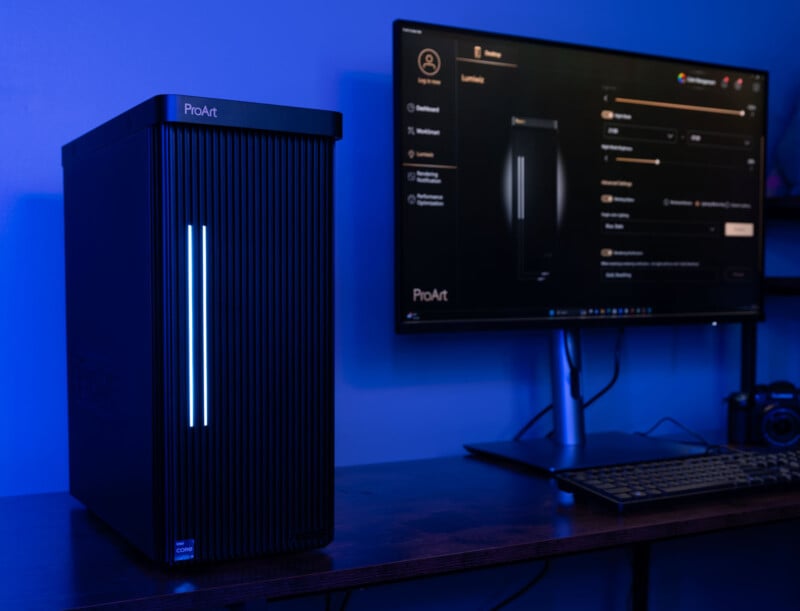
Should You Buy It?
Probably not. If you like the style of the ProArt PD5 and do not care about the latest and fastest ports, then you can make a case for the PD5. However, for everyone else, it is worth looking elsewhere.
The idea behind the ProArt PD5 is absolutely a worthwhile one. There should be desktop computers built for creative professionals that are also relatively simple to use, and the PD5 is not all that far from being great.
However, part of making a computer appealing to “professionals” is ensuring that the performance matches the moniker, and for the ProArt, that is unfortunately not the case. At least not yet.
